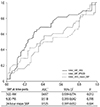Abstract
Background
Methods
Results
Figures and Tables
 | Fig. 1The receiver operating characteristic (ROC) curve for decreased estimated glomerular filtration rate in Diabetic CKD patients. |
Table 1
Baseline characteristics

Data are presented as means±standard deviations or numbers (percentages).
*eGFR, estimated glomerular filtration rate calculated by the Modification of Diet in Renal Disease method; PCR, urine protein/creatinine ratio; SBP, systolic blood pressure; CKD, chronic kidney disease; ACEi, angiotensin esterase inhibitor; ARB, angiotensin receptor blocker; LVH, left ventricular hypertrophy.
†difference between baseline and follow-up values calculated using the paired t-test and the McNemar test.
‡continuous variables expressed as mean±standard deviation.
§Probable LVH was defined as >4 points using the Romhilt-Estes criteria.
Table 2
Association of the SBP at specific time-points (7:00 AM, 9:30 PM) and the 24-hours mean SBP with decreased eGFR*† (linear and logistic regression)

*eGFR, estimated glomerular filtration rate calculated by the Modification of Diet in Renal Disease method (mL/min/1.73m2); SBP, systolic blood pressure; mSBP, mean systolic blood pressure.
†log-transformed, continuous variables.
‡Adjusted for age, sex, smoking, alcohol, body mass index, serum creatinine, urine protein/creatinine ratio, renin angiotensin aldosterone system inhibitor, dipper/non-dipper group (dipper: a ratio of night-time mean SBP to day-time mean SBP ≤0.9/non-dipper: a ratio >0.9).
aF=11.7, p=0.001; F=6.07, p<0.001.
bF=7.37, p=0.008; F=11.0, p<0.001.
cF=13.8, p=<0.001; F=5.75, p<0.001.
§Odds ratio (95% confidential interval).
Table 3
Association of the SBP at specific time-points (7:00 AM, 9:30 PM) and the 24-hours mean SBP with sustained proteinuria*† (linear and logistic regression)

*sustained proteinuria, increased random urine protein/creatinine ratio (mg/gCr) compared to the baseline value; SBP, systolic blood pressure; mSBP, mean systolic blood pressure.
†log-transformed, continuous variables.
‡Adjusted for age, sex, smoking, alcohol, body mass index, serum creatinine, urine protein/creatinine ratio, renin angiotensin aldosterone system inhibitor, dipper/non-dipper group (dipper: a ratio of night-time mean SBP to day-time mean SBP ≤0.9/non-dipper: a ratio >0.9).
aF=9.47, p=0.003; F=5.02, p<0.001.
bF=7.37, p=0.008; F=3.87, p<0.001.
cF=13.8, p<0.001; F=4.54, p<0.001.
§Odds ratio (95% confidential interval).
Table 4
Association between SBP at specific time-points (7:00 AM and 9:30 PM) and the 24-hours mean SBP and renal outcomes* (logistic regression)

*renal outcomes, increased random urine protein/creatinine ratio (mg/gCr) compared to the baseline value or decreased estimated glomerular filtration rate calculated by the Modification of Diet in Renal Disease method (mL/min/1.73m2); SBP, systolic blood pressure; mSBP, mean systolic blood pressure.
†Adjusted for age, sex, body mass index, smoking, alcohol, exercise, initial eGFR, initial proteinuria, renin angiotensin aldosterone system inhibitor, dipper/non-dipper group (dipper: a ratio of night-time mean SBP to day-time mean SBP ≤0.9/non-dipper: a ratio >0.9).
‡Odds ratio (95% confidential interval).
Table 5
Association of the SBP at specific time-points (7:00 AM, 9:30 PM) and the 24-hours mean SBP with decreased eGFR*, sustained proteinuria†, renal outcomes‡ depending on the CKD stage§ (logistic regression)

*decreased eGFR, decreased estimated glomerular filtration rate calculated by the Modification of Diet in Renal Disease method ≥5 (mL/min/1.73m2); SPB, systolic blood pressure; mSBP, mean systolic blood pressure.
†sustained proteinuria, increased random urine protein/creatinine ratio (mg/gCr) compared to the baseline value.
‡renal outcomes, increased random urine protein/creatinine ratio (mg/gCr) compared to the baseline value or decreased estimated glomerular filtration rate calculated by the Modification of Diet in Renal Disease method ≥5 (mL/min/1.73m2).
§late CKD stage: chronic kidney disease stage 3, 4, 5 without dialysis.
∥Adjusted for age, sex, body mass index, smoking, alcohol, exercise, initial eGFR, initial proteinuria, renin angiotensin aldosterone system inhibitor, dipper/non-dipper group (dipper: a ratio of night-time mean SBP to day-time mean SBP ≤0.9/non-dipper: a ratio >0.9)
¶Odds ratio (95% confidential interval).




 PDF
PDF ePub
ePub Citation
Citation Print
Print


 XML Download
XML Download